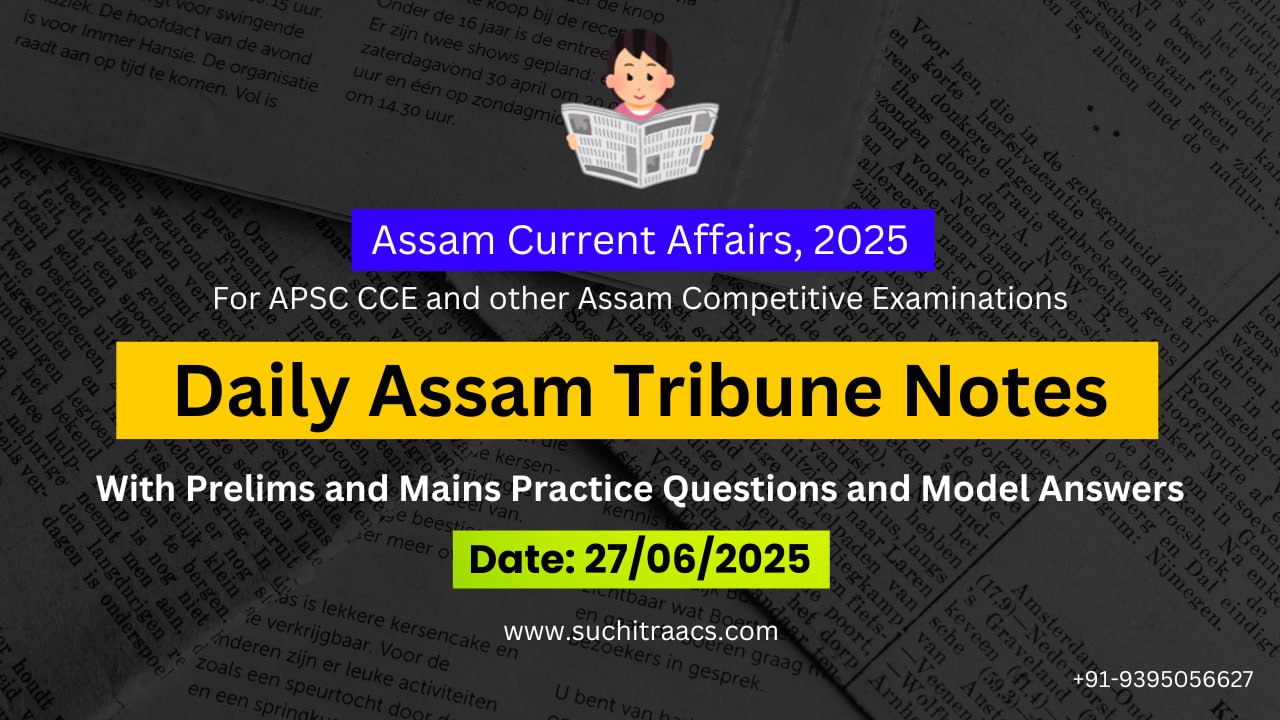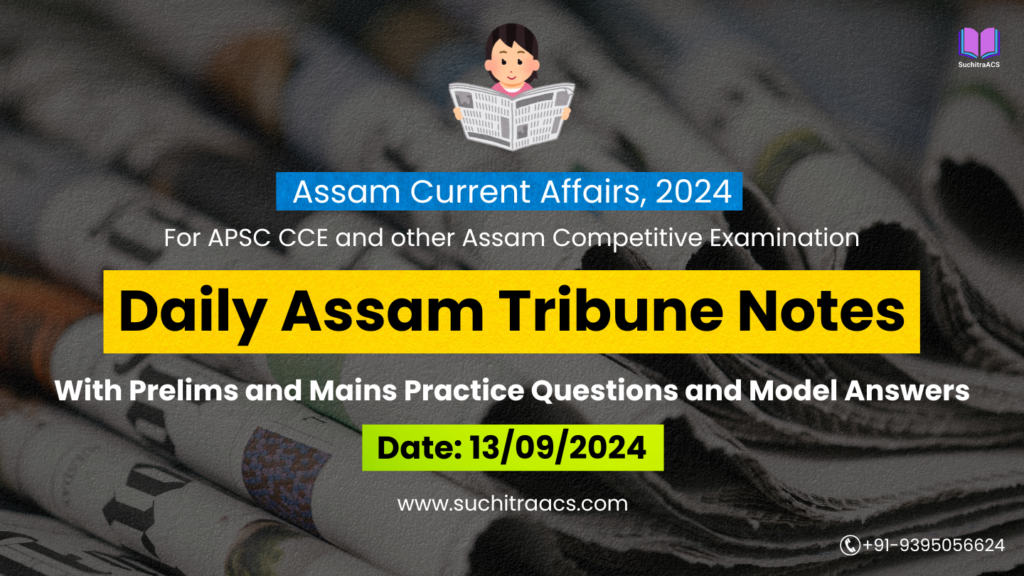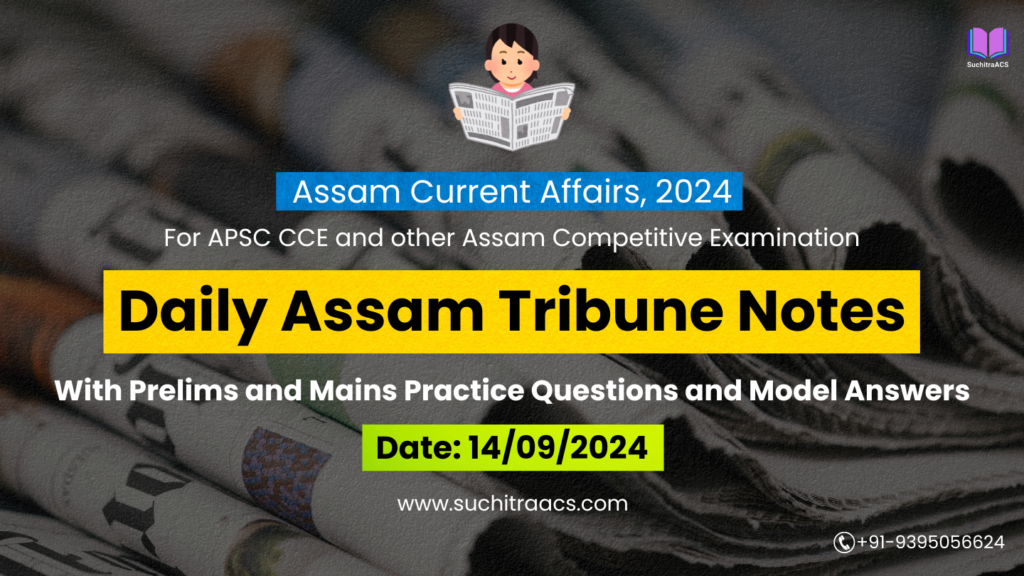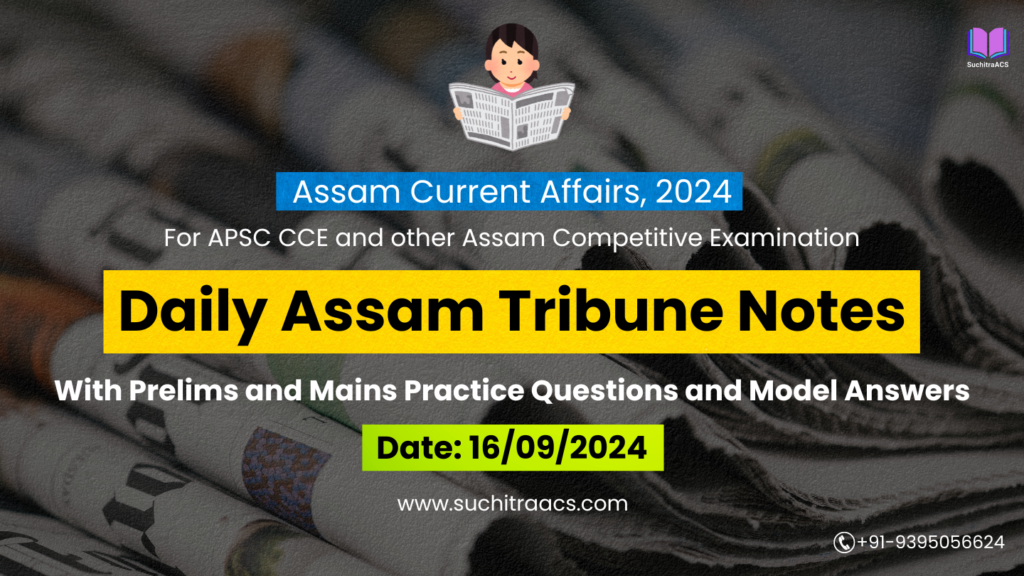APSC Current Affairs: Assam Tribune Notes with MCQs and Answer Writing (27/06/2025)
For APSC CCE and other Assam Competitive examinations aspirants, staying updated with current affairs is vital. This blog covers most important topics from the Assam Tribune today (27-06-2025). These issues are key for both APSC Prelims and Mains preparation, offering insights into the APSC CCE Syllabus.
✨ APSC CCE Online Coaching, 2026

🛫 Operation Sindhu: India’s Evacuation from Iran Amid Iran-Israel Conflict
📘 GS Paper 2: International Relations | Diaspora | Disaster Response
📘 GS Paper 3: Security | Crisis Management | Disaster Preparedness
📘 APSC GS Paper 5: India’s Foreign Policy | Role of MEA in Citizen Safety
🔹 Introduction
Amid escalating tensions between Iran and Israel, India launched Operation Sindhu on 18 June 2025 to evacuate its nationals from the conflict zone. As of 26 June, over 3,400 Indian citizens and several foreign nationals had been successfully repatriated through 14 special flights. The effort reflects India’s growing capability and commitment to citizen protection abroad during international crises.
🔑 Key Facts About Operation Sindhu
| Feature | Details |
| 🚨 Operation Launched | 18 June 2025 |
| 🧭 Region Covered | Iran, with some staging from Armenia & Turkmenistan |
| ✈️ Flights Deployed | 14 flights (till 26 June), from Mashhad, Yerevan, Ashgabat |
| 👥 People Evacuated | 3,426 Indians, 11 OCI cardholders, 9 Nepalese, some Sri Lankans, 1 Iranian spouse |
| 🧳 Return Destinations | Primarily New Delhi |
| 🔄 Coordinating Body | Ministry of External Affairs (MEA) |
🧠 Prelims Pointers
Operation Ganga (2022): Evacuation from Ukraine
Operation Kaveri (2023): Evacuation from Sudan
MEA’s CPV Division: Coordinates overseas citizen support and evacuation
Evacuation Air Routes: Use of third countries like Armenia, Turkmenistan due to no-fly zones
International Humanitarian Law (IHL): Evacuation of civilians during armed conflict
📝 Mains Pointers
A. Importance of Operation Sindhu
| Area | Significance |
| 🇮🇳 Diaspora Welfare | Demonstrates India’s commitment to global Indian communities |
| 🤝 Diplomacy | Showcases India’s neutral stance and capability in crisis mediation |
| 🧭 Regional Stability | India advocating ceasefire, balance in West Asia |
| 🛬 Strategic Planning | Efficient use of staging countries & air corridors |
B. Challenges Encountered
| Challenge | Explanation |
| 🛑 Closed Airspace | Iran and Israel flight restrictions posed logistical barriers |
| 🔍 Locating Nationals | Tracking undocumented Indian workers in conflict zones |
| 🕊️ Diplomatic Sensitivities | Maintaining neutrality amidst Iran-Israel conflict |
| 📞 Communication Gaps | Disruption in mobile/internet in conflict zones |
🧭 Way Forward
| Recommendation | Action Points |
| 📋 Updated Database | Mandatory registration of NRIs with embassies |
| 🚁 Rapid Deployment | Pre-agreements with airlines for emergency evacuations |
| 🤝 Multilateral Support | Partnering with UNHCR, ICRC during crises |
| 📲 Digital Outreach | Crisis-specific mobile apps for emergency contact |
📑 Relevant Documents & Frameworks
Indian Community Welfare Fund (ICWF)
Vienna Convention on Consular Relations (1963)
MEA Standard Operating Procedures for Evacuation
National Policy on Disaster Management (2009) – Overseas Citizen Component
🧩 Conclusion
Operation Sindhu exemplifies India’s growing prowess in strategic diplomacy and humanitarian logistics. As geopolitical tensions rise, India’s readiness and neutral diplomacy will be crucial in safeguarding its global citizenry and international image.
🏞️ Dampa Tiger Reserve in Mizoram Declared India’s First “Climate Refuge for Big Cats”
📘 GS Paper 3: Environment – Biodiversity | Climate Change | Protected Areas
📘 GS Paper 1: Geography – Forest Types | Wildlife Corridors
📘 APSC GS Paper 5: NE India – Ecological Hotspots | Conservation Challenges
🔹 Introduction
The National Tiger Conservation Authority (NTCA), in collaboration with WII and MoEFCC, has declared Dampa Tiger Reserve in Mizoram as India’s first climate refuge for big cats. This designation is based on climate-resilience studies showing that Dampa’s forests will continue to sustain tiger populations even under warming scenarios due to its elevation, dense canopy, and prey base.
🔑 Key Highlights
| Feature | Details |
| 🐅 Protected Area Type | Tiger Reserve (since 1994) |
| 📍 Location | Western Mizoram, bordering Bangladesh |
| 🌿 Core Area | 500 sq km (approx), part of Indo-Myanmar Biodiversity Hotspot |
| 🌡️ Climate Refuge Status | First in India; based on long-term species resilience modelling |
| 🧬 Key Fauna | Clouded leopard, barking deer, Hoolock gibbon, wild boar |
| 📊 Supporting Agencies | WII, NTCA, MoEFCC, Mizoram Forest Dept |
🧠 Prelims Pointers
Dampa Tiger Reserve: Only Tiger Reserve in Mizoram; near Indo-Bangladesh border
Climate Refuge: Area that remains ecologically suitable for a species despite global warming
WII: Wildlife Institute of India – conducts tiger census and habitat research
NTCA: National Tiger Conservation Authority – statutory body under MoEFCC
Indo-Myanmar Biodiversity Hotspot: One of the 36 global biodiversity hotspots; covers NE India
📝 Mains Pointers
A. Importance of Dampa as a Climate Refuge
| Value Type | Benefit |
| 🧬 Biodiversity | Sustains rare species like clouded leopard and gibbons |
| 🌡️ Climate Shield | Elevation and canopy buffer temperature rise |
| 🛡️ Tiger Habitat | Supports long-term population planning for tigers in NE |
| 🌱 Ecosystem Services | Preserves river basins, carbon sequestration, soil conservation |
| 📚 Research Potential | Ideal for long-term ecological and climate impact studies |
B. Conservation Challenges in Dampa
| Challenge | Explanation |
| 🚶♂️ Jhum Cultivation | Traditional shifting agriculture encroaching into buffer zones |
| 🛣️ Fragmented Corridors | Poor connectivity to Kaziranga–Pakke–Namdapha–Dampa belt |
| 🧍♂️ Low Tiger Density | Currently fewer than 5 tigers as per last estimation |
| 🔥 Forest Fires | Slash-and-burn practices raise wildfire risk |
| 🧑🤝🧑 Human–Wildlife Conflict | Grazing, minor forest produce collection causing stress |
📑 Related Policies & Initiatives
Project Tiger (1973, ongoing)
National Wildlife Action Plan (2017–2031) – includes climate-proofing conservation
State CAMPA Funds – for afforestation and eco-restoration
India’s Tiger Census (Status of Tigers Report) – WII & NTCA partnership
Green Skill Development Programme (GSDP) – trains local eco-volunteers
🧭 Way Forward
| Recommendation | Strategy |
| 🌐 Strengthen Corridors | Restore links to Pakke, Namdapha via ecodevelopment |
| 🧑🌾 Eco-livelihood Schemes | Alternative income for shifting cultivators |
| 🔬 Long-term Monitoring | Set up climate-biodiversity observatories |
| 🚷 Eco-tourism Regulation | Cap numbers, avoid core area intrusion |
| 📚 Environmental Education | Train local youth as tiger stewards, citizen scientists |
🧩 Conclusion
Dampa’s designation as India’s first climate refuge for big cats is a landmark in adaptive conservation planning. As climate change threatens lowland habitats, such refuges offer hope for long-term species survival and regional biodiversity resilience—especially in Northeast India.
🌐 India Refuses to Sign SCO Joint Statement Over Belt and Road Clause
📘 GS Paper 2: International Relations | Bilateral and Multilateral Groupings | Foreign Policy Principles
📘 APSC GS Paper 5: India and Neighbourhood | Role of Regional Groupings
🔹 Introduction
India, while participating in the Shanghai Cooperation Organisation (SCO) Summit, refused to sign the joint statement on economic cooperation due to references supporting China’s Belt and Road Initiative (BRI). India has long maintained that the BRI, particularly its China–Pakistan Economic Corridor (CPEC) component, violates India’s sovereignty as it passes through Pakistan-occupied Kashmir (PoK).
🔑 Key Highlights
| Element | Detail |
| 📍 Event | SCO Summit – Economic Forum, 2025 |
| 🛑 India’s Objection | Belt and Road Initiative clause |
| 🌏 Forum Involved | SCO – Eurasian regional intergovernmental body |
| 🇮🇳 India’s Position | Respect for sovereignty & territorial integrity is non-negotiable |
| 🇨🇳 BRI Component in Issue | CPEC through Gilgit-Baltistan region in PoK |
| 🤝 Participation Status | India remains an active member but selectively engages |
🧠 Prelims Pointers
SCO Members: China, India, Russia, Pakistan, Kazakhstan, Kyrgyzstan, Tajikistan, Uzbekistan, Iran (joined 2023)
CPEC: China–Pakistan Economic Corridor – ~$60 billion infrastructure plan; passes through PoK
BRI: Belt and Road Initiative – China’s global infrastructure push, launched 2013
India’s Position: First opposed BRI at 2017 Belt & Road Forum
SCO Secretariat: Based in Beijing
📝 Mains Pointers
A. India’s Strategic Concerns with SCO
| Concern | Explanation |
| 🗺️ Sovereignty Violation | CPEC violates Indian territorial claims |
| ⚖️ Uneven Power Balance | China dominates SCO agenda-setting |
| 🇵🇰 Indo-Pak Friction | Limited scope for meaningful cooperation |
| 🧊 Divergent Interests | India not aligned with BRI, unlike other SCO members |
| 🔍 Limited Institutional Depth | SCO lacks enforcement or dispute resolution frameworks |
B. Why India Stays Engaged with SCO
Counterterrorism Dialogue – RATS (Regional Anti-Terrorist Structure)
Energy Security – Cooperation with Central Asian nations
Connectivity Alternatives – Supports INSTC, Chabahar instead of BRI
Strategic Signaling – Keeps diplomatic presence in Eurasian affairs
Balancing China–Russia Dynamics – Asserting multipolarity
📑 Policy Frameworks & Context
India’s “Connect Central Asia” Policy (2012)
New Delhi Declaration (2020) – India called for “respect for sovereignty”
India–Iran–Afghanistan Chabahar Port – India’s BRI alternative
Act East + Extended Neighbourhood Policy – Northeast as gateway to SE Asia and beyond
🧭 Way Forward
| Recommendation | Strategy |
| 📜 Continue Conditional Engagement | Attend summits, avoid compromising on core interests |
| 🚧 Promote Alternative Corridors | Push for INSTC, BIMSTEC, and Chabahar connectivity |
| 🤝 Strengthen Regional Consensus | Build bloc with like-minded nations on sovereignty norms |
| 🌍 Leverage Multipolar World Order | Play balancing role among China, Russia, West |
| 🗣️ Public Diplomacy | Clarify India’s position to domestic and global audiences |
🧩 Conclusion
India’s refusal to endorse the SCO statement reflects a principled stance on sovereignty, even within multilateral platforms. As China pushes its strategic agenda through BRI, India must assert its red lines, while still engaging in regional diplomacy that serves its broader economic and security interests.
🧑⚖️ Meghalaya HC Criticizes Internet Shutdowns Without Legal Justification
📘 GS Paper 2: Governance – Fundamental Rights | Role of Judiciary
📘 GS Paper 3: Internal Security – Cyber Governance | Public Order
📘 GS Paper 5 (APSC): Rights-Based Governance | Role of Judiciary in NE States
🔹 Introduction
The Meghalaya High Court sharply criticized the state government’s internet shutdowns, stating that blanket bans without legal justification violate citizens’ rights under Article 19 and 21. The court’s remarks were made in a suo motu PIL after repeated internet suspensions during civil unrest.
🔑 Key Observations
| Feature | Details |
| ⚖️ Court | Meghalaya High Court |
| 📜 Constitutional Rights | Article 19(1)(a) – Freedom of speech and expression |
| 🛑 Issue | Arbitrary internet shutdowns by state without Telecom Act compliance |
| 🧑💻 Bench’s Observation | “Shutdowns must be proportional, necessary, and legally defensible.” |
| 🔄 Legal Framework Invoked | Anuradha Bhasin v. Union of India (2020 SC verdict) |
🧠 Prelims Pointers
Article 19(1)(a): Freedom of speech, including digital expression
Article 21: Right to life includes access to information and livelihood
Telegraph Act, 1885 – Section 5(2): Legal basis for internet suspensions
Anuradha Bhasin case: SC ruled internet access is part of Article 19; shutdowns must meet tests of necessity and proportionality
Temporary Suspension Rules, 2017: Governs internet bans (amended in 2020)
📝 Mains Pointers
A. Significance of the Court’s Stand
| Importance | Explanation |
| 🧑⚖️ Rule of Law Upheld | Reminds the executive of constitutional guardrails |
| 🌐 Digital Rights Affirmed | Internet seen as enabler of speech, education, business |
| 🧭 Federal Accountability | Pushes NE states to comply with national-level guidelines |
| ⚖️ Judicial Oversight | Reinforces role of judiciary as protector of civil liberties |
B. Broader Implications for Northeast India
| Concern | Reality |
| 🛑 Frequent Shutdowns | Manipur, Assam, and Meghalaya often use blanket shutdowns |
| 🧑🎓 Education Disruption | Students suffer during exams or classes |
| 💼 Livelihood Loss | Affects gig economy, farmers using e-portals |
| 🗣️ Rights Dilution | Silences peaceful protest and local journalism |
| 🌐 Digital Divide | Widens inequality in hilly and tribal areas |
📑 Related Legal Frameworks & Judgments
Anuradha Bhasin v. Union of India (2020)
Foundation for Media Professionals v. Union of India (2020) – upheld digital rights during COVID
Temporary Suspension of Telecom Services Rules (2017) – Centralised review required
Information Technology Act (2000) – Regulates content but not shutdowns
🧭 Way Forward
| Recommendation | Strategy |
| 🧑⚖️ Mandatory Judicial Review | All shutdowns >24 hrs should need court sanction |
| 📊 Public Transparency | Publish shutdown orders on official websites |
| 🛠️ Tech for Precision | Geo-fencing instead of state-wide shutdowns |
| 🧑🎓 Digital Literacy & Rights | Train local officials on constitutional digital rights |
| 📱 Alternative Response Plans | Use social media control instead of blanket bans |
🧩 Conclusion
The Meghalaya HC’s intervention reinforces that security must not come at the cost of civil liberties. In a digital democracy, judicious, lawful, and proportional internet governance is essential—especially in sensitive regions like the Northeast where connectivity is already fragile.
APSC Prelims Practice Questions
✅ Topic 1: Operation Sindhu – India’s Evacuation from Iran
1. Operation Sindhu was launched by India to evacuate its nationals from which country?
A. Sudan
B. Ukraine
C. Iran ✅
D. Afghanistan
🧠 Explanation:
Operation Sindhu (2025) was launched to evacuate Indians stranded in Iran due to escalating Iran–Israel conflict. Comparable operations include Ganga (Ukraine) and Kaveri (Sudan).
2. Which division of the Ministry of External Affairs (MEA) is responsible for coordinating such evacuations?
A. Eurasia Division
B. Consular, Passport and Visa (CPV) Division ✅
C. Economic Diplomacy Division
D. External Publicity Division
🧠 Explanation:
The CPV Division handles Indian citizen services abroad, including emergency evacuations and crisis management.
✅ Topic 2: Dampa Tiger Reserve – Climate Refuge for Big Cats
3. Dampa Tiger Reserve is located in which Indian state?
A. Assam
B. Arunachal Pradesh
C. Mizoram ✅
D. Tripura
🧠 Explanation:
Dampa Tiger Reserve, declared in 1994, is located in western Mizoram, near the Bangladesh border.
4. Which of the following correctly describes a “Climate Refuge”?
A. A region that has low rainfall throughout the year
B. A zone that remains ecologically stable despite climate change ✅
C. A migration center for birds
D. A flood-prone wetland
🧠 Explanation:
A climate refuge refers to an area expected to remain habitable for key species even under changing climatic conditions, such as temperature and rainfall variation.
5. Which of the following organisations are involved in tiger conservation in India?
- National Tiger Conservation Authority (NTCA)
- Wildlife Institute of India (WII)
- Zoological Survey of India (ZSI)
- Indian Council of Forestry Research and Education (ICFRE)
Select the correct answer:
A. 1 and 2 only ✅
B. 1, 2 and 3 only
C. 1, 2 and 4 only
D. All of the above
🧠 Explanation:
NTCA and WII are the two key agencies behind India’s tiger conservation and monitoring programs like the Status of Tigers in India Report.
✅ Topic 3: India Refuses to Sign SCO Joint Statement
6. India’s refusal to sign the SCO joint statement was due to opposition to which initiative?
A. Eurasian Economic Union
B. Belt and Road Initiative ✅
C. QUAD Maritime Security Charter
D. Shanghai Treaty of Friendship
🧠 Explanation:
India opposed the SCO joint statement as it contained a clause endorsing China’s Belt and Road Initiative (BRI), which India rejects over sovereignty concerns (CPEC passing through PoK).
7. The Belt and Road Initiative (BRI) is primarily associated with which country?
A. Russia
B. China ✅
C. Iran
D. Kazakhstan
🧠 Explanation:
The BRI is China’s global infrastructure and connectivity initiative launched in 2013.
8. Which of the following countries are members of the Shanghai Cooperation Organisation (SCO)?
- India
- Iran
- Myanmar
- Russia
Select the correct answer:
A. 1, 2 and 4 only ✅
B. 1, 3 and 4 only
C. 2, 3 and 4 only
D. All of the above
🧠 Explanation:
India, Iran, and Russia are full members of the SCO. Myanmar is not a member.
✅ Topic 4: Meghalaya HC on Internet Shutdowns
9. Which landmark Supreme Court judgment ruled that internet access is protected under Article 19 of the Constitution?
A. Navtej Singh Johar v. Union of India
B. Anuradha Bhasin v. Union of India ✅
C. K.S. Puttaswamy v. Union of India
D. Romesh Thappar v. State of Madras
🧠 Explanation:
In Anuradha Bhasin v. Union of India (2020), the Supreme Court declared that freedom of speech and trade via internet is protected under Article 19(1)(a) and 19(1)(g).
10. The legal power to suspend telecom services in India (including internet) is derived from:
A. IT Act, 2000
B. Indian Penal Code
C. Telegraph Act, 1885 ✅
D. Press and Registration of Books Act, 1867
🧠 Explanation:
Section 5(2) of the Telegraph Act, 1885, and the Temporary Suspension Rules (2017) provide the framework for internet shutdowns in India.
APSC Mains Practice Question
📝 Mains Question:
Q. Examine the significance of India’s recent refusal to endorse the SCO joint statement over the Belt and Road Initiative (BRI). What does this decision reveal about India’s foreign policy priorities and strategic autonomy in multilateral forums?
📘 Model Answer
Introduction
At the 2025 Shanghai Cooperation Organisation (SCO) Summit, India chose not to sign the joint economic cooperation statement due to its implicit endorsement of China’s Belt and Road Initiative (BRI). This move highlights India’s consistent opposition to the BRI—especially its China–Pakistan Economic Corridor (CPEC) component, which violates India’s sovereignty by passing through Pakistan-occupied Kashmir (PoK).
Why India Opposes the BRI
| Reason | Explanation |
| 🗺️ Sovereignty Concerns | CPEC infringes on Indian territorial claims in PoK |
| 🧭 Lack of Transparency | BRI projects have been criticized for opaque financing |
| 💰 Debt Diplomacy Risks | Several BRI participants (e.g., Sri Lanka) have faced debt crises |
| 🌍 Strategic Imbalance | BRI is viewed as China’s geopolitical tool, especially in South Asia |
Implications for India’s Foreign Policy
A. Assertion of Strategic Autonomy
- India’s decision reflects an independent and principle-based foreign policy, resisting pressure from powerful neighbours like China and blocs like SCO.
- It reinforces India’s credibility as a sovereign player even in multilateral platforms.
B. Diplomatic Balance
- India continues to engage with SCO members on issues like counterterrorism, energy, and connectivity, without compromising its core interests.
- This selective engagement is part of issue-based alignment, not bloc alignment.
C. Regional Signaling
- The move sends a message to China and Pakistan that territorial integrity is non-negotiable.
- Simultaneously, India uses platforms like INSTC, Chabahar, and BIMSTEC to promote alternative connectivity.
Challenges Arising from This Stand
| Challenge | Details |
| 🤝 Trust Deficit with China | May worsen already tense Sino-Indian relations |
| 🌍 Limited Leverage in SCO | India may find itself isolated in a China-led SCO |
| 🧭 Balancing Multiple Forums | Requires finesse in dealing with Russia, Iran, and Central Asia |
| 📉 Influence Dilution | Non-signature may reduce India’s say in economic policies of SCO |
Way Forward
| Recommendation | Strategy |
| 🛤️ Promote Own Corridors | Strengthen Chabahar Port, North–South Transport Corridor, Act East |
| 🤝 Deepen Central Asia Ties | Use soft power, education, and trade to expand influence |
| 🗣️ Diplomatic Clarity | Clearly articulate India’s conditional participation in joint communiqués |
| 📊 Regional Coalitions | Partner with Iran, Kazakhstan, and Russia on alternate regional projects |
Conclusion
India’s refusal to sign the SCO joint statement is not isolationism—it is a principled assertion of sovereignty and strategic clarity. As multilateralism becomes more complex, India must pursue flexible engagement that safeguards its interests while contributing meaningfully to regional cooperation.
✨ APSC CCE Courses, 2025-26 offered by SuchitraACS


🔔 Join Our WhatsApp Study Group!
For exclusive access to premium quality content, including study materials, current affairs, MCQs, and model answers for APSC CCE and other Assam competitive exams.
Click here to join: SuchitraACS Study WhatsApp Group
📚 Want to know more about SuchitraACS’s most affordable courses?
Click here to know more: SuchitraACS Courses for APSC CCE and Assam Competitive Examinations




